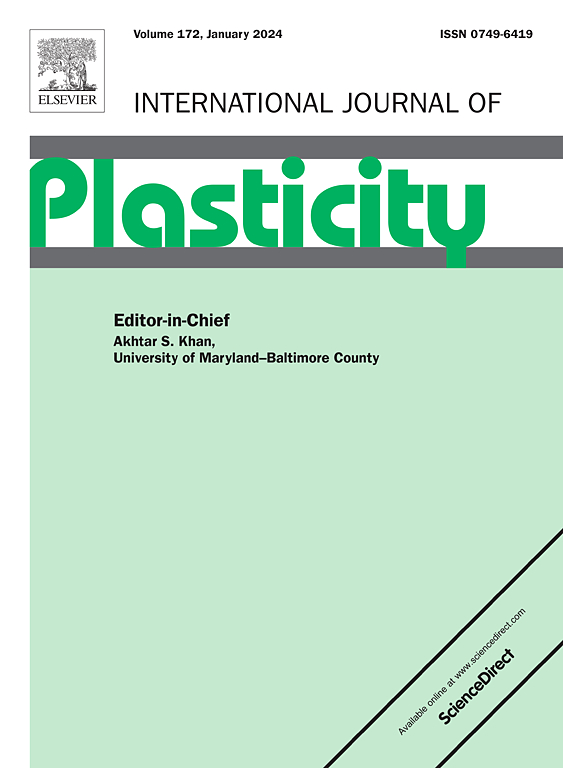尺寸对多晶材料塑性行为的影响:晶粒尺寸、析出状态和自由表面效应
IF 12.8
1区 材料科学
Q1 ENGINEERING, MECHANICAL
引用次数: 0
摘要
采用厚度按材料晶粒大小顺序排列的超薄试样研究了表面效应。候选材料是一种多晶镍基高温合金(Alloy 718),有意热处理以记录晶粒尺寸和冶金状态(即固溶体和沉淀硬化状态)对多晶到多晶行为的影响。采用专用工艺制备超薄拉伸试样,得到厚度为20 ~ 550 μmμm的试样,并在室温下进行拉伸试验。发现多晶到多晶转变(PMT)取决于相对于试样厚度的材料晶粒尺寸,并严重损害材料的抗拉强度。对于厚度小于材料晶粒尺寸两倍的试样,无论其冶金状态如何,屈服强度、极限抗拉强度(应力-应变曲线上的最大应力)和破坏应变均显著下降。这种拉伸性能的下降主要是由于自由表面效应作为位错的逃逸汇,从而导致表面晶粒内的初级位错密度与芯晶相比显著降低。有趣的是,两种析出态的加工硬化行为随尺寸减小而不同,固溶态对尺寸减小更为敏感。拉伸性能的下降并没有像通常报道的“厚度/晶粒尺寸(t/Dt/D)”比所期望的那样。因此,本文采用基于连续晶体塑性方法的改进的berveille - zaoui自一致模型进行了数值分析,以区分强化(位错积聚)和软化(自由表面位错逃逸)等微观结构特征。使用Voronoi镶嵌方法生成三维数值材料,以表示“核心颗粒”与“表面颗粒”的比例。然后将这些分数用作显微结构参数,用于使用具有不同晶粒种群的平均场均质化(即核心与表面特征)来识别晶体塑性模型。本工作旨在通过不同厚度的试样、不同的显微组织和冶金状态变体来区分Alloy 718 ni基高温合金的表面晶粒和核心晶粒的力学行为。本文章由计算机程序翻译,如有差异,请以英文原文为准。
Size effects on the plastic behavior of polycrystalline materials: Grain size, precipitation state and free-surface effects
Surface effects were investigated using ultrathin specimens with thicknesses in the order of the grain size of the material. The candidate material was a polycrystalline Ni-based superalloy (Alloy 718) purposely heat treated to document both the effects of the grain size and the metallurgical state, , solid solution and precipitation hardened state, on the polycrystalline-to-multicrystalline behavior. Ultrathin tensile specimens were prepared with a dedicated technique to obtain specimens with thicknesses ranging between 20 and 550 , then tensile tested at room temperature. The polycrystalline-to-multicrystalline transition (PMT) was found to depend on the material grain size relative to the specimen thickness and to impair severely the tensile strength of the material. The yield strength, ultimate tensile strength (maximal stress on the stress–strain curve) and strain-to-failure severely dropped for specimens thinner than approximately two times the grain size of the material regardless of the metallurgical state. Such a decrease in tensile properties is mainly attributed to free-surface effects acting as an escape sink of dislocations, thus leading to a significant decrease of the primary dislocations density within the surface grains in comparison with the core grains. Interestingly, difference in work-hardening behavior with size reduction was found between both precipitation states, the solid solution state being more sensitive with the size reduction. The decrease in tensile properties was not found as expected from the commonly reported “thickness/grain size ()” ratio. Therefore, a numerical approach using a modified Berveiller–Zaoui self-consistent model based on a continuum crystal plasticity approach was conducted in the present paper to distinguish microstructural features acting as strengthening (dislocation accumulation) and softening (dislocation escape at the free-surface) features. 3D numerical materials were produced using Voronoi tessellation methods to represent the fraction of “core grains” versus “surface grains”. These fractions were then used as microstructural parameters for the identification of a crystal plasticity model using mean-field homogenization with different populations of grains, , core versus surface features. The present work aimed at distinguishing the mechanical behavior of surface grains from core grains in Alloy 718 Ni-based superalloys using various thicknesses of specimens and different microstructure and metallurgical state variants.
求助全文
通过发布文献求助,成功后即可免费获取论文全文。
去求助
来源期刊

International Journal of Plasticity
工程技术-材料科学:综合
CiteScore
15.30
自引率
26.50%
发文量
256
审稿时长
46 days
期刊介绍:
International Journal of Plasticity aims to present original research encompassing all facets of plastic deformation, damage, and fracture behavior in both isotropic and anisotropic solids. This includes exploring the thermodynamics of plasticity and fracture, continuum theory, and macroscopic as well as microscopic phenomena.
Topics of interest span the plastic behavior of single crystals and polycrystalline metals, ceramics, rocks, soils, composites, nanocrystalline and microelectronics materials, shape memory alloys, ferroelectric ceramics, thin films, and polymers. Additionally, the journal covers plasticity aspects of failure and fracture mechanics. Contributions involving significant experimental, numerical, or theoretical advancements that enhance the understanding of the plastic behavior of solids are particularly valued. Papers addressing the modeling of finite nonlinear elastic deformation, bearing similarities to the modeling of plastic deformation, are also welcomed.
 求助内容:
求助内容: 应助结果提醒方式:
应助结果提醒方式:


